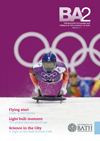 Did you know that in an overlooked corner of the Library is a treasure trove of University history, which tells the story of our campus and its inhabitants over almost 50 years? Molly Conisbee finds out what’s in the University Archives and Research Collections.
Did you know that in an overlooked corner of the Library is a treasure trove of University history, which tells the story of our campus and its inhabitants over almost 50 years? Molly Conisbee finds out what’s in the University Archives and Research Collections.
Tucked away at the back of the University’s Library is a veritable treasure trove: from photographs, magazines, old exam papers, student newspapers and letters, to official records, meeting minutes, payroll and pension files, prospectuses and more. All of this is overseen by University Archivist, Lizzie Richmond, who, since 1998, has been the guardian of this fantastic repository.

Lizzie is responsible for managing, maintaining and properly cataloguing the University’s archives. In doing this she must draw on her training as an historian to make decisions about what actually constitutes a valuable and ‘archive worthy’ object or document. “There are certain routine official documents that must be kept for legal, regulatory or operational reasons,” explains Lizzie, “but we also get sent lots of more unusual things that need to be sifted and assessed, to establish their value as an historical record of the institution.”
One of the hardest things to capture in an archive is some of the more ephemeral paraphernalia that might seem trivial at its moment of production, but can actually tell you volumes about how life on campus felt during certain eras. Amateur photographs, protest posters, information about gigs and concerts and sporting events, leaflets, flyers and student magazines are often amongst the best expressions of their zeitgeist.
An exciting new project hopes to digitise and catalogue a collection of old footage of campus life, mainly taken from former student TV recordings. These offer fascinating glimpses – not just at the fashions and phraseology of yesteryear – but also the changing physical features and landscape of campus as we have aged and expanded. As Lizzie remarks, “Understanding the experience of being a student here 20 or 30 years ago is much better expressed through a few short moments of fi lm than any number of meeting minutes. That’s one of the reasons I’d love to track down the keen photographers and fi lm-makers within our alumni community, to see if they have footage or pictures we can add to the collection. They offer an amazingly evocative glimpse of the campus through its history. And every year the student magazine had an ‘official’ photographer, so we know you’re out there!”
Some of the photographs in the archives – such as students swimming in the Roman Baths, or pushing a Fiat-500 around the city streets (this was apparently a popular game) – show the way that, for example, health and safety regulations have changed over time. Some of these larks clearly date from before the city was designated a World Heritage Site. Nowadays the University is very proud of its strong connection to the beautiful city of Bath, but as Lizzie notes, “It’s interesting to see how the external face of the University has changed. In the late 1960s and 1970s we were really proud of our cutting edge and modern campus and this was refl ected in printed institutional publications that tended to be quite formal. Over time our relationship with the City, which was always important, has come to feature more prominently. Now the University produces a huge amount of promotional material in a wide variety of media – most of it is heavily design-based and a bit more relaxed. This tells you lots about branding and changes in marketing techniques and how the University’s image has evolved.”
As well as being a repository of University records, the archive has been the lucky recipient of some research collections of wider, national and international importance. Hockey’s national governing body chose Bath to host the archives of the All England Women’s Hockey Association documenting the beginnings and early development of organised hockey played by women in the UK. The collection is fascinating not just to those who play the sport, it also offers an insight into social history and women’s experiences, because it tells the story of the changing ideas of acceptability in women’s dress; the practicalities of where women could (and could not) tour; the fact that the organisation was kept – deliberately – an all-women’s affair.
“It’s a wonderful resource,” recounts Lizzie. “I hope a student or academic here will explore it more thoroughly at some point, as this is an important piece of social, sporting and cultural history.”
The University also holds research collections relating to judo, rightwing politics, underwater acoustics, modern pentathlon, regional architecture, steam engines, botanical ecology, spelling reform, the SS Great Eastern, phonetics and Pitman’s shorthand.
“The archives are the University’s memory,” says Lizzie. “There are inevitably gaps in the collection, and we can’t really ever have enough things to go in it – especially the ‘off-the-record’ stuff, the things that capture the experience of studying or teaching here. “I hope our latest project digitising film footage will bring the memories of studying and living here flooding back for former students and staff. And better yet if that encourages people to send us some of their pictures or memorabilia.”
Police on campus
Alumnus Neil Jarman (BSc Building Engineering 1982) was kind enough to share some of his memories with the University archive. In his first term in 1978 he went to a concert at University Hall (many alumni remember amazing gigs they attended on campus in the 1970s and 1980s). Neil recalls, “The main act was a comedy trio called ‘Alberto y Los Trios Paranoias’. The support act was a then little-known band who called themselves ‘The Police’. The support band duly impressed all of us who attended.
“Sure that they would make the big time, I acquired one of the few posters put up for the concert. It was on my wall for a few years, including the Students’ Union President’s office during my sabbatical year.”
Neil has kindly donated his precious poster to the archive, where Lizzie has carefully stored it for future generations to enjoy.
Can you help us tell the story of our first 50 years? If you have any posters, photos or other memorabilia that you would like to donate to or share with the archive as we approach our 50th anniversary, please contact the Alumni Relations team at alumni@bath.ac.uk
Responses





I have images of my time at Bath university on engineering metallurgy course plus passing out of students 1972 also the rag of 1969